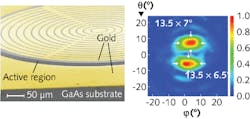TERAHERTZ SOURCES: Concentric-grating terahertz QCLs five times more powerful than ridge QCLs
Quantum-cascade lasers (QCLs) operating in the terahertz region of the electromagnetic spectrum are in demand for numerous spectroscopy, communications, and imaging applications; however, ridge-waveguide-based terahertz QCLs with the commonly adopted metal-metal waveguide configuration suffer from a relatively low output power and a large beam divergence of approximately 180º as well as multimode operation. While smaller divergence angles on the order of 10º are possible using external or integrated optics, low output power and multimode operation persist.
An alternative terahertz QCL developed by researchers at Nanyang Technological University (NTU) and the Singapore Institute of Manufacturing Technology (both in Singapore), as well as the University of Leeds (Leeds, England), Hong Kong Polytechnic University (Kowloon, Hong Kong), and Shanghai Jiao Tong University (Shanghai, China) takes advantage of the circular symmetry of concentric circular gratings (CCGs) to develop vertical-emission QCLs with low divergence that are five times more powerful than their ridge-waveguide QCL counterparts.1
Circular symmetry
Through numerical simulations using a commercial COMSOL (Burlington, MA) finite-element analysis tool, the research team developed an optimized concentric circular grating (CCG) using a two-dimensional (2D) partial-differential-equation mode in the COMSOL software. The modeling step takes the mode profile of vertical emission into account, producing a device optimized for terahertz operation at approximately 3.75 THz with a laser-gain medium sandwiched between the CCG at the top and a lower metal plate at the bottom. The optimal parameters of the CCG for maximum emission from the terahertz grating-based laser were an outer ring thickness of 16.2 μm and a total ring diameter of 356.7 μm with carefully engineered slots in each ring.
The concentric rings of the optimized metal-based CCG are electrically connected together via a three-spoke structure so that the entire gain medium below the CCG can be electrically pumped (see figure). The laser gain medium was fabricated using molecular beam epitaxy with a gallium arsenide/aluminum gallium arsenide (GaAs/Al0.15Ga0.85As) structure. The CCG structures were defined by standard optical lithography and liftoff, and the final active region was wet-etched into the circular form.
Experimental analysis of the CCG terahertz QCLs showed operation up to 110 K compared to 130 K for conventional ridge-waveguide QCLs. However, the CCG QCLs exhibited stable single-mode operation (rather than multimode), at peak power levels of tens of milliwatts—around 5X higher than for comparably sized ridge-waveguide QCLs.
The far-field pattern of the CCG QCLs was a dual-lobed 13.5º × 7º shape due to boundary deformation of the active region occurring during anisotropic wet chemical etching for the circular fabrication portion of the process. Using an isotropic etching technique (like plasmon etching) could avoid this boundary-deformation problem.
“This approach opens up new opportunities in achieving functional beam control such as polarization control, beam steering, and special beams, while holding the single-mode operation simultaneously,” says NTU assistant professor Wang Qijie, lead author of this work. “The design is also simple by taking advantage of the circular symmetry, which is easily implemented.”
“In the near future, we aim to realize ring-shaped and radially polarized light emission by removing the laser boundary deformation,” says NTU Ph.D. student Liang Guozhen. “Such emission is highly desirable for efficient coupling when launching terahertz waves into a terahertz metal-wire waveguide or the metallic tip of a terahertz near-field imaging system. In addition, one can also achieve a narrower single-lobed far-field pattern by further optimizing the CCG structure.”
REFERENCE
1. G. Liang et al., Opt. Exp., 21, 26, 31872–31882 (2013).

Gail Overton | Senior Editor (2004-2020)
Gail has more than 30 years of engineering, marketing, product management, and editorial experience in the photonics and optical communications industry. Before joining the staff at Laser Focus World in 2004, she held many product management and product marketing roles in the fiber-optics industry, most notably at Hughes (El Segundo, CA), GTE Labs (Waltham, MA), Corning (Corning, NY), Photon Kinetics (Beaverton, OR), and Newport Corporation (Irvine, CA). During her marketing career, Gail published articles in WDM Solutions and Sensors magazine and traveled internationally to conduct product and sales training. Gail received her BS degree in physics, with an emphasis in optics, from San Diego State University in San Diego, CA in May 1986.
